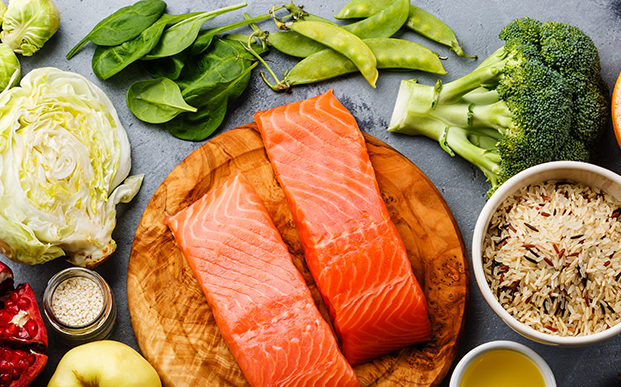19 foods that will help you live longer and better

What you eat can boost your immunity, your health and your longevity. Here, the best foods for a long life — and which ones to avoid.
Longevity isn’t just about delaying death — it’s about enjoying more years of health and vitality. In her book, The Longevity Diet, dietician Leslie Beck outlines the ways food choices affect the aging process and help to delay the onset of age-related chronic illnesses.
First, certain foods can cause or prevent inflammation in the body. We’re not just talking arthritis; chronic inflammation also contributes to illnesses like Alzheimer’s disease, heart attack and type 2 diabetes. Foods that are high in antioxidants, omega-3 fatty acids, monounsaturated fat and phytochemicals promote the production of anti-inflammatory compounds. In contrast, foods which are high in fat, refined sugars and refined starches can promote inflammation.
Second, foods containing high levels of antioxidants combat the harmful effects of free radicals — compounds which can damage proteins, cell membranes and genes. Free radical damage accumulates over the years when the body can’t produce enough of its own antioxidant enzymes to keep up. You’ve likely heard some of the big names like polyphenols, phytochemicals (such as flavonoids, beta carotene and resveratrol), vitamins C and E and selenium.
Article Continued Below…..
Finally, as we age, our bodies become less sensitive to insulin and the pancreas has to work overtime to compensate. The result: a condition known as insulin resistance which can lead to type 2 diabetes. Maintaining low, consistent levels of insulin is essential for longevity, and we can help by choosing foods which release glucose more slowly rather than causing spikes in blood glucose levels. These choices are known as low glycemic foods — the ones that score the lowest on the glycemic index (GI).
So what are the top foods for a long life? Scroll through to see some of Beck’s top choices.
Top Foods for Longevity
1. Almonds. Love them for their vitamin E and healthy fats. They make a great addition to salads and cereals, or enjoy almond butter on toast, apples or crackers.
What about other nuts? Experts agree that most nuts offer healthy benefits too. For instances, walnuts have a hefty dose of alpha linolenic acid (ALA) content — an omega-3 fatty acid that helps reduce inflammation.
2. Avocados. This fruit is a not just a source of healthy fat, it’s also got folate (an essential B-vitamin) as well as vitamin B6, potassium and glutathione, a powerful antioxidant. Its creamy texture works well in dips and spreads.
3. Beets. Those bright pigments are thought to help ward off certain cancers like colon cancer. They’re also high in folate and manganese, and the betaine found in beets can help fight aging and inflammation. Try roasting them along with other winter vegetables or grate them on a salad.
4. Berries and red fruits. Need another excuse to enjoy berries? They’re packed with antioxidants. Toss them on your cereal or yoghurt, or enjoy them as a snack.
Other red fruits like pomegranates and red grapes also offer a host of protective compounds. Red grapes are known for their resveratrol content, which helps fight inflammation, and pomegranates are packed with polyphenols that are good for the heart and guard against lung and prostate cancer.
5. Broccoli. This cruciferous veggie contains sulforaphane, kaempferol and other phytochemicals that fight free radicals. Try roasting broccoli for a tasty change of routine or toss it on pizza.
6. Cabbage. Got to love those glucosinolates — another type of phytochemical that target free radicals. Try it in a sandwich instead of lettuce or braise it with apples and red wine.
7. Dark chocolate. Yes, you can treat yourself. Unlike milk or white chocolate, dark chocolate containing 70 per cent cocoa or more is packed with flavonoids. But don’t over do it — a small square is all you need.
8. Flaxseed. Flaxseed offers cancer-preventing phytochemicals and is an excellent source of alpha linolenic acid or ALA (an omega-3 fat) and lignans, which can help prevent heart disease. It’s easy to add to foods like cereals, cookies, meatloaf and stews, and can also be used to replace eggs in recipes.
9. Garlic. There are many reasons to enjoy this potent member of the onion family, including sulphur compounds that boost the immune system and prevent many cancers. It’s also good for the heart because it can prevent blood from forming dangerous clots and can help lower cholesterol.
10. Green tea. Served hot or cold, this popular beverage contains catechins, which fight inflammation and improve blood vessel functioning. Try drinking it hot (with lemon and honey), or iced with a shot of your favourite fruit juice.
11. Kale. It has high fibre content, calcium, iron, vitamins A, C and K. Kale is also packed with antioxidants, and sulforaphane and a compound called indoles — both of which can help prevent cancer. Kale holds its shape in stir-fries and soups, and makes a crunchy snack when baked.
12. Legumes. While most dried beans provide plenty of fibre and plant-based protein, black beans get the nod for having the most antioxidant content. Beans and other legumes are also low glycemic carbohydrates — meaning they release their glucose slowly.
Short on time? Try lentils — they don’t require pre-soaking and cook up quickly. Toss them in pasta sauce instead of ground meat or add them to any soup, stew or salad.
13. Oats. They have all the phytochemicals and nutrients of other whole grains, but they really shine for their beta-glucane content (which lowers bad cholesterol) and avenanthramides (which protect LDL cholesterol particles from free radicals).
14. Extra-virgin olive oil. It’s the go-to oil for its healthy monounsaturated fats, vitamin E content and phytochemicals. It’s not just for cooking — mix it up with some balsamic vinaigrette for a tasty dressing.
15. Oranges. Famous for their vitamin C, oranges also offer phytochemicals that help prevent disease. Another bonus: enjoying whole fruit instead of juice offers up fibre as well.
16. Red bell peppers. Known for their vitamin C and beta-carotene content. You’re better off eating red peppers raw or lightly cooked as overcooking can damage the vitamins.
17. Salmon and other omega-3-rich fish. No surprise, it’s the high levels of fatty acids that make these choices a mainstay in the longevity diet. Trout, Arctic char, sardines and herring are other low-mercury options to try.
18. Soybeans. Like other legumes, they’re rich in nutrients but they’re also a “complete protein” — meaning they offer all the essential amino acids. They also offer isoflavones, which are thought to reduce the risk of breast and prostate cancer.
19. Spinach. Experts can’t get enough of this leafy green because of the vitamins A and C, beta-carotene and flavonoids content. Other leafy greens top many superfood lists as well.
Foods to Cut Back
Notice what’s not on this list? The usual culprits: red meat, processed meats, refined sugars and starches and sodium can all contribute to weight gain, insulin resistance and inflammation. You don’t have to cut these foods completely from your diet, but limiting them is a step in the right direction.
What about alcohol? Get ready for some controversy. Some studies say a drink a day is good for you, while other research suggests that alcohol can have harmful effects. Ultimately, it’s up to individuals (and their doctors) to weigh the benefits versus the risks of a drink or two a day.





